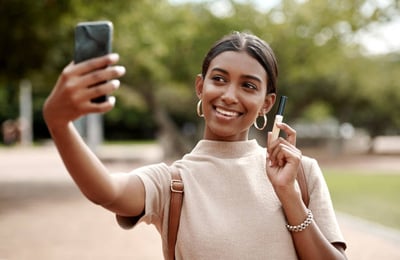August 31, 2023
 by Gaurav Sharma / August 31, 2023
by Gaurav Sharma / August 31, 2023

Every brand wants publicity.
However, with increasing competition and dwindling attention spans, acquiring and retaining customers is not always easy. Marketers now face various challenges in getting the right attention as consumers no longer connect with self-marketing strategies.
But what if there was a way to get people to talk about your brand instead of using a traditional outbound marketing approach? The solution lies in buzz marketing.
Buzz marketing is a marketing technique that creates visibility and excitement around a brand through word-of-mouth promotion tactics. It's like a chain reaction, where marketers kickstart an unconventional campaign and draw customers using buzz.
Tools like social media monitoring software are perfect for identifying trends, tracking competitors, and understanding customer sentiment. All of these elements go a long way in supporting buzz marketing.
But what exactly is "buzz"? It could be a picture, an idea, a sentence, a quote, a video, or some other marketing ploy. However, it's almost always absurd, unique, or truly phenomenal. After all, a buzz is what makes people talk (or not) about your brand.
When done right, buzz marketing helps:
Both buzz marketing and viral marketing have similar goals. However, they differ in development and use. The following differentiators can help you choose one of the two popular marketing styles.
The main difference between buzz and viral marketing is how each reaches an audience. A viral campaign slowly picks up speed and builds up gradually with each release. On the other hand, buzz marketing explodes quickly, i.e., directs and simultaneously sends messages to a large audience.
In viral marketing, the campaign is the main focus. Additionally, a viral message evokes a certain feeling or emotion. Conversely, buzz marketing gets people to talk about the brand, not just the message. This is why the latter is generally preferred when launching a new product.
Viral marketing campaigns are mainly carried out on social media. For buzz marketing, the first trigger could come from an offline event like a street performance or a product testing campaign, helping reach thousands of people instantly.
Source: Attrock
You need to give users something to talk about for buzz marketing to work.
According to Mark Hughes, the brain behind "buzz marketing," six different conversion starters, known as buzz buttons, determine a campaign's health. Let's understand what these six possibilities are.
Taboo usually refers to controversial subjects beyond the safe and boring, like politics or veganism. Everyone has an answer or opinion on these topics. A prominent example of taboo is how some news channels handle controversies to get people to talk about their shows.
Similarly, using taboo buttons in a marketing campaign can help attract more attention. However, it's important to be careful and keep within limits when dealing with sensitive issues.
The unusual conversation starter offers your audience something unique, something out of the blue. It gets your brand noticed and sets it apart from the competition.
The brands often use "the unusual" to bring a new product to market and spark a discussion about it. It can include something never seen before or off the norm.
When a restaurant goes beyond expectations and treats you to a spectacular dining experience, you tell people, don't you? Then "the remarkable" trigger activates. It may be the easiest for brands to implement as it relies on customer satisfaction.
Here, the goal is to create something better than average and offer a great customer experience.
Remember, average and ordinary are no longer enough for consumers. On-time customer support, a flexible return policy, and fast delivery pave the way for a great buzz marketing campaign.
The last three triggers are relatively harder to apply in businesses.
Outrageous triggers take consumers by surprise. Several brands rely on "the outrageous" to grab attention and improve recall value. The outrageous can involve funny, shocking, sad, or just any emotion.
You need to make sure this type of buzz marketing relates to your brand. We all may laugh at a commercial but forget the brand name when sharing about it. Does the brand benefit from this? Not really.
Hilarious is one of the most popular buzz buttons. It relies on humor to grab and keep the audience's attention. Hilarious content spreads like wildfire because we're always looking for reasons to laugh.
The secret is the sixth and final buzz button. People are curious about things withheld from them. They want to learn more about something mysterious and take pride in sharing secrets.
One way to use this technique is to give select customers a glimpse into a product not yet launched or behind the scenes at your company. The idea is to make people feel like they're on the inside. Secrets or even messages to something bigger are a great way to get buzz around your brand.
By now, you probably know how effective buzz marketing is. Here are three examples of brands that successfully implemented this strategy and inspired many others.
Starbucks relies heavily on buzz marketing to stay popular and relevant with its audience. One of the first things that spring to mind when we hear about Starbucks is its leading customization tactic of writing customers' names on coffee mugs.
Many customers voluntarily share these mugs' pictures on their social accounts, helping Starbucks gain free publicity. Even misspelled names get a lot of online attention. Take a look at the number of posts for the hashtag #starbucksnamefail on Instagram.
Source: Instagram
This isn't all. Starbucks even taps the surprise buzz button via its secret menu. Coffee lovers don't find these drinks on the menu. They need to ask the barista to prepare it specifically. Most flavors are unique and unknown, such as Butterbeer Latte and Apple Pie Frappuccino.
People find out about these drinks through mere word-of-mouth. Starbucks picks a few loyal customers to get the word out on social media.
In 2019, Peloton released a commercial that was widely criticized for showing women in a certain light. Aviation Gin hired the same actress from the Peloton commercial for its ad, successfully leveraging humor to spark a conversation about its liquor by skillfully relating it to a current scandal.
Source: YouTube
In 2020, the social audio app Clubhouse took the internet by storm. Thanks to its buzz marketing strategy, it grew exceptionally quickly. The platform had invitation-only membership, which made users want to head over to the platform.
Within a few nights, the clubhouse became the talk of the town, leaving internet users desperate for invitations.
Source: Twitter
To decide if buzz marketing is for your business, you need to understand its pros and cons. Let's take a look.
Here are some of buzz marketing's main advantages:
Buzz marketing has some drawbacks too. Some of these are:
Now that you know what buzz marketing is, why it's so effective, and the different types, it's time to get down to brass tacks. Here are six easy steps to generate the buzz you need.
What's the first thing you do when you start developing a marketing campaign? You think about your audience. If you don't understand your audience, you can't address them. This marks your buzz marketing campaign's failure.
So, start by creating buyer personas that represent your ideal customer.
Once you know your buyer persona(s), you can easily choose a suitable buzz marketing technique.
Brands want to see everything people say about them in one place. A branded hashtag helps you with this. A hashtag marketing strategy also makes it a breeze to collect customer feedback after your campaign is over.
Finally, when you access all of the content under one hashtag, monitoring success is pretty easy too. So, make sure to include your hashtag when posting a buzz marketing campaign.
Source: Instagram
Even if you started a campaign offline, make it a point to talk about it on every social platform you're on. Tweak the content for each platform as needed.
For buzz marketing to work, you need to provide some value to your audience. So, put out high-quality content, making prospects want to learn more about your brand, share it with their friends, and eventually convert them into customers.
Source: Twitter
Make the most of your email subscribers. Closely examine your list and weed out active users – loyal customers who're most likely to read your email. Then send them emails offering perks like free subscriptions, coupons, or discounts. Finally, encourage them to become ambassadors by sharing more about your brand with other interested prospects.
You can try influencer marketing or reach out to brand ambassadors for better visibility and reach. Influencers have a good social media presence and a highly engaged audience. They also know what kind of content works for their followers. Since their opinions are taken quite seriously, it's easy to capitalize on them and build a buzz around your product.
You can start by simply giving select influencers a newly released product as a gift and asking them to share an honest review on social media, together with your brand hashtag, of course.
Source: Instagram
However, be sure to choose the right channels for influencer marketing. You don't want to pick a platform where your buyer personas don't even hang out.
Your buzz marketing campaign doesn't end until you evaluate its success.
For example, you can use analytics tools to analyze metrics such as your website's traffic performance or views on your YouTube video. Simply put, you use your usual marketing key performance indicators (KPIs) to see if you're achieving your goals.
Gauge whether your brand's performance improved with your buzz marketing campaign. If not, try to understand what went wrong and use this data to inform future marketing campaigns.
Now let's go over some of the best hacks, tips, and ideas for a successful buzz marketing campaign.
Your brand and product need to be in the spotlight, but keep in mind that people drive buzz marketing campaigns. So, always keep your audience in the backdrop. Think about their interests, pain points, hobbies, and needs if you want to create a real buzz.
You've probably seen e-commerce websites offering flash sales. Flash sales work pretty much on a scarcity principle. The reason it works is simple. People value scarce things more.
The idea is to reduce a product's availability while the demand remains the same. Brands that successfully apply the scarcity principle are often labeled as exclusive, allowing them to charge a premium price for their products.
If you want to draw more from your buzz marketing efforts, you need to offer something better to your audience. Each of the buttons Mark Hughes described is an effective way to create campaigns. But what if you combine two of these?
For example, instead of just being unusual, do something unusual and hilarious. This leads to more people wanting to share your content.
Video marketing works well for many reasons. It is visually stimulating, memorable, highly shareable, conveys messages easily, and can trigger strong emotions. This is pretty much everything your buzz marketing message needs to be. You should come up with ideas that you can bring to life through video content.
Even if you create a massive buzz among your audience, it isn't good for your brand if your product doesn't live up to expectations. You could end up losing existing customers and struggling to find new ones. So make sure your brand and product match the hype your buzz marketing campaign generates.
Buzz marketing is a low-commitment way of spreading brand awareness. All you need to do is understand your audience, have a clear goal, a quality product, and the right approach.
Brands from all over the world are already benefiting from this stellar strategy and growing their business. When are you hopping on the bandwagon?
Now that you know what goes into successfully leveraging buzz marketing, read more about content marketing, a parallel marketing style that produces gradual yet steady results.
Gaurav Sharma is a digital marketing professional and a regular contributor to top publications like HuffPost, Adweek, Business 2 Community, TechCrunch, and more.
So, you’re ready to delve into the world of influencer marketing.
 by Trelawney Erwin
by Trelawney Erwin
User-generated content (UGC) is no longer just a nice addition for brands.
 by Haley Fraser
by Haley Fraser
Ten years ago, the concept of hiring a social media manager seemed outlandish to most brands.
 by Haley Fraser
by Haley Fraser
So, you’re ready to delve into the world of influencer marketing.
 by Trelawney Erwin
by Trelawney Erwin
User-generated content (UGC) is no longer just a nice addition for brands.
 by Haley Fraser
by Haley Fraser


